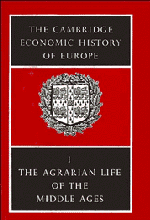Book contents
- Frontmatter
- Chapter I The Settlement and Colonization of Europe
- Chapter II Agriculture and Rural Life in the Later Roman Empire
- Chapter III The Evolution of Agricultural Technique
- Chapter IV Agrarian Institutions of the Germanic Kingdoms from the fifth to the ninth century
- Chapter V Agrarian conditions in the Byzantine Empire in the Middle Ages
- Chapter VI The Rise of Dependent Cultivation and Seignorial Institutions
- Chapter VII Medieval Agrarian Society in its Prime
- §1 France, The Low Countries, and Western Germany
- §2. Italy
- §3 Spain
- §4 The lands east of the Elbe and German colonization eastwards
- §5 Poland, Lithuania and Hungary
- §6 Russia
- §7 England
- §8 Scandinavia
- Chapter VIII Crisis: From the Middle Ages to Modern Times
- BIBLIOGRAPHIES
- Plate Section
- The Roman frontier and the Teutonic Tribes in the first and fourth centuries A.D.
- The Empire of Charles the Great
- Germany in the thirteenth century
- References
§5 - Poland, Lithuania and Hungary
from Chapter VII - Medieval Agrarian Society in its Prime
Published online by Cambridge University Press: 28 March 2008
- Frontmatter
- Chapter I The Settlement and Colonization of Europe
- Chapter II Agriculture and Rural Life in the Later Roman Empire
- Chapter III The Evolution of Agricultural Technique
- Chapter IV Agrarian Institutions of the Germanic Kingdoms from the fifth to the ninth century
- Chapter V Agrarian conditions in the Byzantine Empire in the Middle Ages
- Chapter VI The Rise of Dependent Cultivation and Seignorial Institutions
- Chapter VII Medieval Agrarian Society in its Prime
- §1 France, The Low Countries, and Western Germany
- §2. Italy
- §3 Spain
- §4 The lands east of the Elbe and German colonization eastwards
- §5 Poland, Lithuania and Hungary
- §6 Russia
- §7 England
- §8 Scandinavia
- Chapter VIII Crisis: From the Middle Ages to Modern Times
- BIBLIOGRAPHIES
- Plate Section
- The Roman frontier and the Teutonic Tribes in the first and fourth centuries A.D.
- The Empire of Charles the Great
- Germany in the thirteenth century
- References
Summary
After the conclusion of the Union with Poland in 1386, Lithuania was constantly under Polish influence, which made itself felt particularly in the conditions under which the large landed estates were held, and in the whole agrarian structure. The relations between Poland and Hungary on the other hand were much looser. There were only two short periods in the fourteenth century and another in the fifteenth when these two states were under a common ruler. Neither country directly influenced the other, and yet they have many features in common both in their political and in their economic structure. It is accordingly permissible to present the agrarian history of all three countries in the Middle Ages in a single chapter.
Landownership
The earliest documents throwing any light on the agrarian structure of Poland date from the beginning of the twelfth century. The land was at that time in the possession of the monarch, of the Church, or of the rural population who had inhabited the country for several centuries and are called by the sources sometimes contributes, ‘fellow-tribesmen’, but more frequently haeredes, ‘heirs’. The growth of state organization led to a distinction between the general mass of the people and the knightly class, who later became the nobility and gentry and held the greater part of the land right down to the time when Poland lost its independence. There were both larger and smaller landowners among this class; but in the twelfth and early thirteenth centuries there was not yet that wide difference between the farms of the peasants and the estates of the gentry that there was in later times.
Keywords
- Type
- Chapter
- Information
- Publisher: Cambridge University PressPrint publication year: 1966



